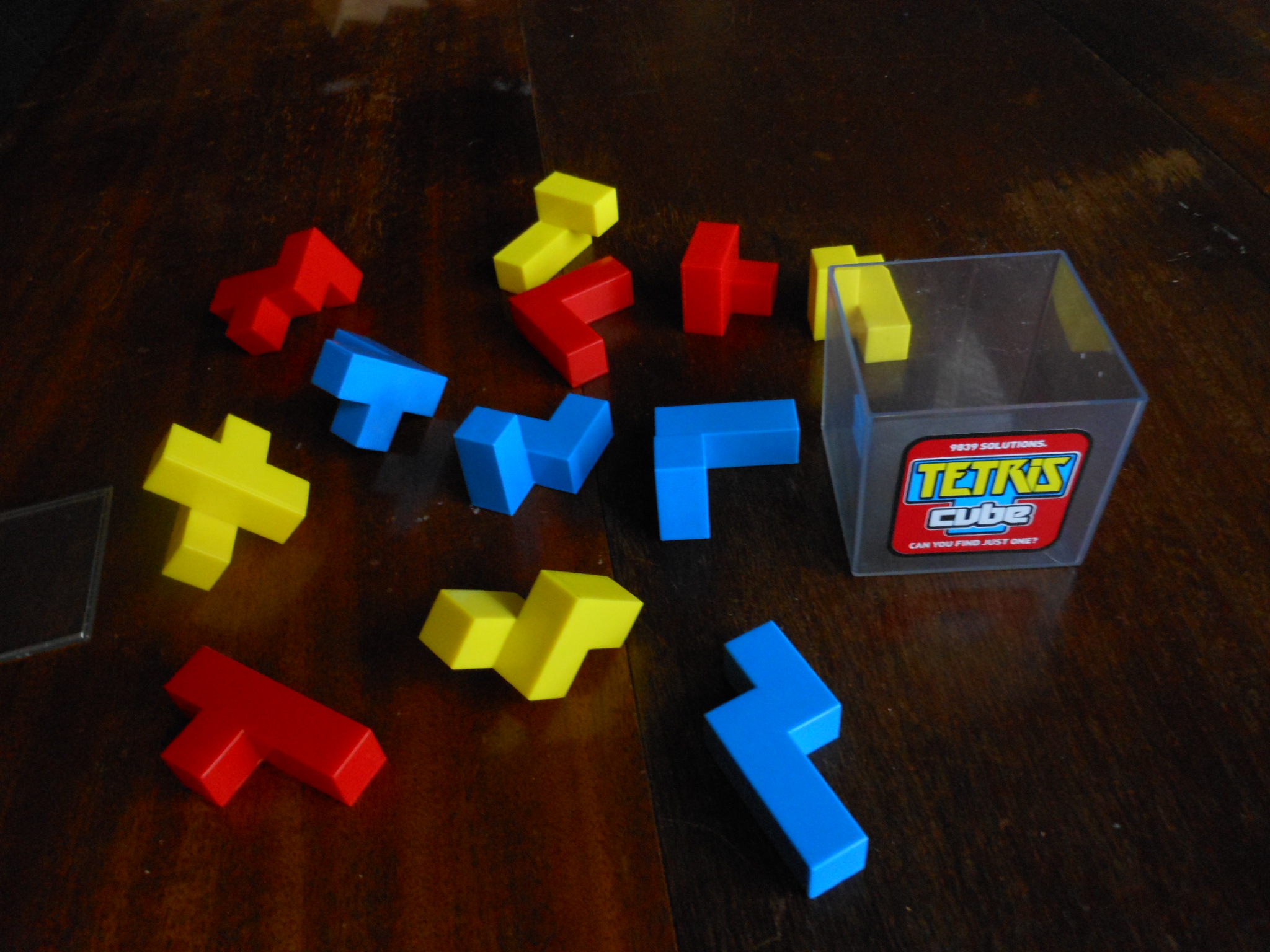This is the story of a friendly competition I engaged in with Haitao, one of my coworkers. We raced to find the solution to a plastic puzzle called the Tetris Cube that the office obtained somehow. He solved it by hand. I wrote a Python script. I didn't tell Haitao that it was a race, and it's unclear who won.
Tetris Cube consists of twelve colored, plastic, tetris-like pieces which go together to make a cube.
Here is a picture of the pieces:

This is the program I wrote:
import numpy as np
orientations = map(np.matrix, [
[[1, 0, 0], [0, 1, 0], [0, 0, 1]],
[[1, 0, 0], [0, 0, -1], [0, 1, 0]],
[[1, 0, 0], [0, -1, 0], [0, 0, -1]],
[[1, 0, 0], [0, 0, 1], [0, -1, 0]],
[[1, 0, 0], [0, 1, 0], [0, 0, 1]],
[[0, 0, -1], [0, 1, 0], [1, 0, 0]],
[[-1, 0, 0], [0, 1, 0], [0, 0, -1]],
[[0, 0, 1], [0, 1, 0], [-1, 0, 0]],
[[1, 0, 0], [0, 1, 0], [0, 0, 1]],
[[0, -1, 0], [1, 0, 0], [0, 0, 1]],
[[-1, 0, 0], [0, -1, 0], [0, 0, 1]],
[[0, 1, 0], [-1, 0, 0], [0, 0, 1]]])
piece_templates = {
"red t/" : [(0,0,0), (1,0,0), (2,0,0), (3,0,0), (2,1,0)],
"yellow tx" : [(1,0,0), (0,1,0), (1,1,0), (2,1,0), (1,0,1)],
"yellow zz" : [(1,0,0), (0,1,0), (1,1,0), (1,0,1), (2,0,1)],
"yellow t+" : [(1,0,0), (0,1,0), (1,1,0), (2,1,0), (1,1,1), (1,2,1)],
"yellow Ll" : [(0,0,0), (1,0,0), (2,0,0), (0,0,1), (0,1,1)],
"red T," : [(2,0,0), (0,1,0), (1,1,0), (2,1,0), (1,2,0), (2,0,1)],
"red O'" : [(0,0,0), (1,0,0), (1,1,0), (0,1,0), (0,0,1)],
"red L" : [(0,0,0), (1,0,0), (2,0,0), (0,1,0), (0,2,0)],
"blue L'" : [(0,0,0), (1,0,0), (2,0,0), (0,1,0), (0,2,0), (1,0,1)],
"blue z" : [(0,0,0), (1,0,0), (2,0,0), (2,1,0), (3,1,0)],
"blue zl" : [(1,0,0), (2,0,0), (0,1,0), (1,1,0), (2,0,1)],
"blue rl" : [(0,0,0), (1,0,0), (2,0,0), (0,1,0), (2,0,1), (2,0,2)]}
def transform(m, piece):
def t(p):
y = p*m
return (y.item(0), y.item(1), y.item(2))
return set(map(t, piece))
def translate(v, piece):
def t(p):
return (v[0]+p[0], v[1]+p[1], v[2]+p[2])
return set(map(t, piece))
def extreme(foo, index, piece):
def t(p):
return p[index]
return reduce(foo, map(t, piece))
def all_fits(pt):
result = []
for m in orientations:
piece = transform(m, pt)
for i in range(-extreme(min, 0, piece), 4-extreme(max, 0, piece)):
for j in range(-extreme(min, 1, piece), 4-extreme(max, 1, piece)):
for k in range(-extreme(min, 2, piece), 4-extreme(max, 2, piece)):
result.append(translate((i,j,k), piece))
return result
initial_fitmap = {}
for name in piece_templates:
initial_fitmap[name] = all_fits(piece_templates[name])
def solve(piecesplaced, fitmap):
if len(fitmap)==0:
i = 0
print '\n'
for name in initial_fitmap:
print name, piecesplaced[i]
i+=1
print '\n'
return
newfitmap = {}
dirt = set().union(*piecesplaced)
def cull(s):
return dirt.isdisjoint(s)
firstname = fitmap.keys()[0]
firstfit = filter(cull, fitmap[firstname])
if len(firstfit) == 0:
return
for name in fitmap.keys()[1:]:
newfit = filter(cull, fitmap[name])
if len(newfit) == 0:
return
newfitmap[name] = newfit
for piece in firstfit:
solve(piecesplaced + [piece], newfitmap)
print "solving..."
solve([], initial_fitmap)
print "... done solving"
Haitao started solving the puzzle by hand using wits and elbow-grease. I secretly wrote the program and left it running over night. The next day, I saw a printed solution on my screen. Haitao still had the pieces at his desk. He finished the puzzle that morning. Then later I verified that the program's solution was correct, by assembling by hand according to the program's output.
So, who was the winner? Hard to call.